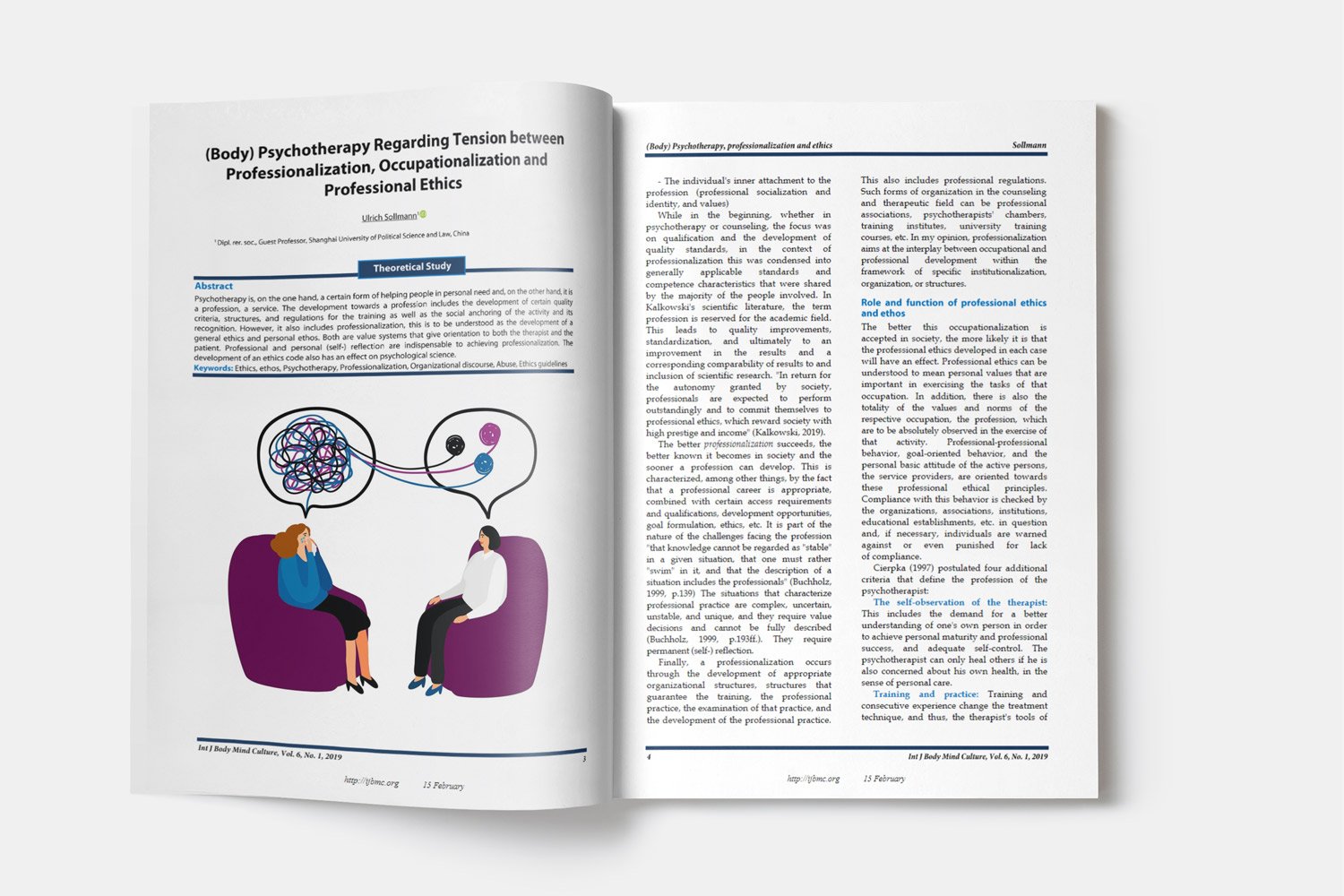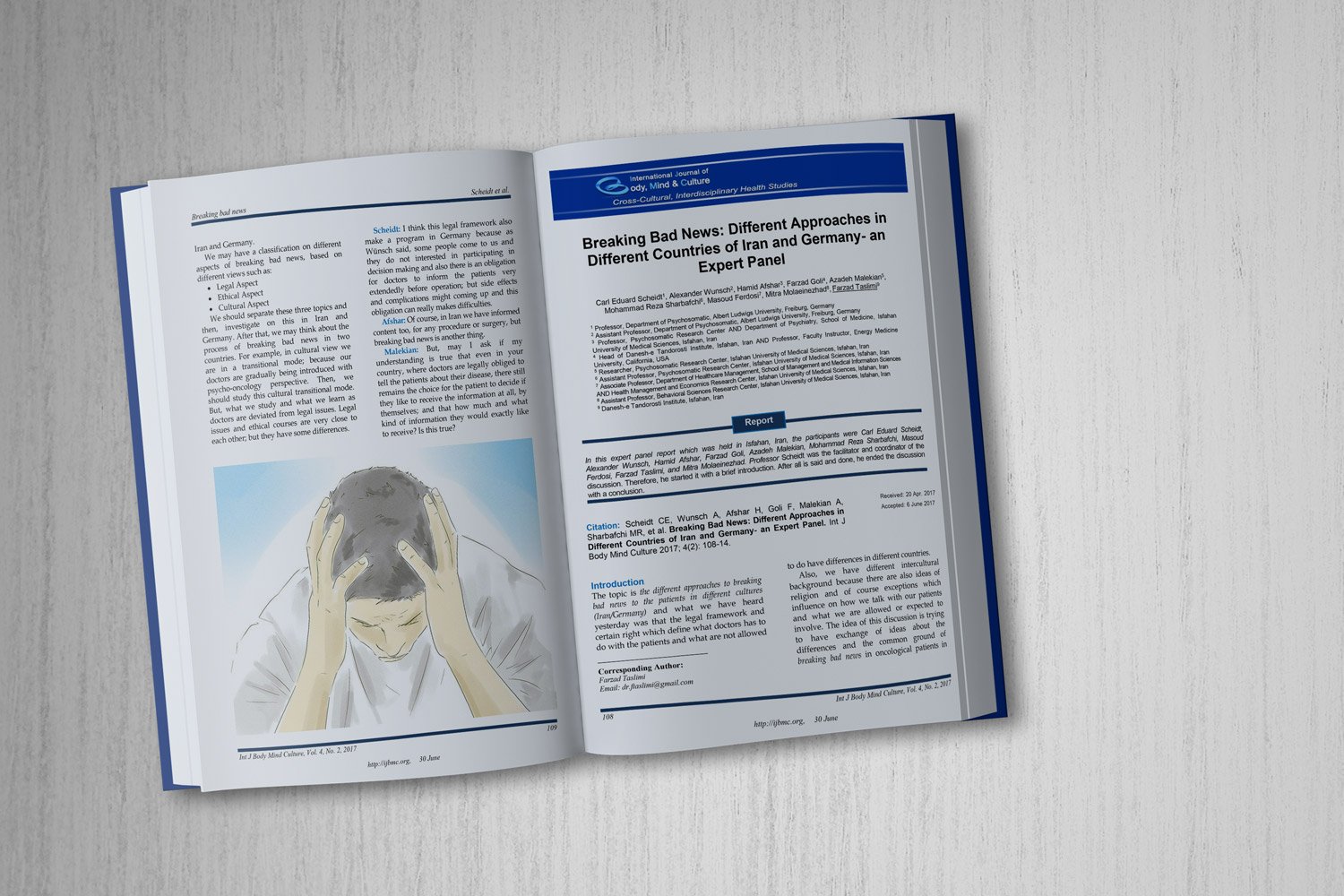Embodiment in Patients with Bipolar Disorder: A Dynamic Model
Embodiment in patients with bipolar disorder
Downloads
Background: Bipolar disorder (BD) is usually studied under the static description and biological etiology, and hence the subjective experience of patients is rarely investigated. This study aimed to investigate the dynamic system of patients with BD through their lived experience in general and their embodiment in specific.
Methods: The current research was qualitative and it was done through the interpretative phenomenological analysis (IPA) method. Semi-structured interviews were conducted with Iranian participants in 2020 through WhatsApp and Skype. 11 participants with BD type I and II were selected through purposive sampling.
Results: The two super-ordinate themes were identified: body in the foreground/background of consciousness and change of power in the body. Themes related to each of them were identified and reported in the phases of depression and mania. The first super-ordinate theme included these themes: hyperembodiment (in depression) and disembodiment (in mania). Painful body (in depression) and heroic body (in mania) were the themes identified in the second super-ordinate theme.
Conclusion: At the psychopathological level, our findings encourage the using of dynamic model for patients with BD in order to extend the possibility of psychotherapy for this group of patients.
Downloads
Akiskal, H. S. (2003). Validating 'hard' and 'soft' phenotypes within the bipolar spectrum: Continuity or discontinuity? J Affect Disord, 73(1-2), 1-5. doi:S0165032702003907 [pii];10.1016/s0165-0327(02)00390-7 [doi]. Retrieved from PM:12507732
Akiskal, K. K., & Akiskal, H. S. (2005). The theoretical underpinnings of affective temperaments: Implications for evolutionary foundations of bipolar disorder and human nature. J Affect Disord, 85(1-2), 231-239. doi:S0165-0327(04)00249-6 [pii];10.1016/j.jad.2004.08.002 [doi]. Retrieved from PM:15780693
American Psychiatric Association. (2013). Diagnostic and Statistical Manual of Mental Disorders. 5th ed. Arlington, VA: American Psychiatric Publishing.
Binswanger, L. (1963). Being-in-the-World: Selected Papers of Ludwig Binswanger (J. Needleman, Trans.). London: Condor Books. Collection of Binswanger's case studies and key papers, particularly those outlining his theory of the existential 'a priori' (as opposed to his work on love and 'we-hood'). Includes an extensive introduction to this aspect of his work.
Bird, D. (2015). Phenomenological psychopathology and an embodied interpretation of manic bipolar experience [PhD Thesis]. Copenhagen, Denmark: University of Copenhagen.
BOWDEN, H. M. (2013). A Phenomenological Study of Mania and Depression [PhD Thesis]. Durham, England: Durham University.
Carvalho, A. F., Firth, J., & Vieta, E. (2020). Bipolar disorder. N.Engl.J Med, 383(1), 58-66. doi:10.1056/NEJMra1906193 [doi]. Retrieved from PM:32609982
Colombetti, G. (2017). The embodied and situated nature of moods. Philosophia.(Ramat.Gan.), 45(4), 1437-1451. doi:9817 [pii];10.1007/s11406-017-9817-0 [doi]. Retrieved from PM:30147178
Curtiss, J., & Klemanski, D. H. (2016). Taxonicity and network structure of generalized anxiety disorder and major depressive disorder: An admixture analysis and complex network analysis. J Affect Disord, 199, 99-105. doi:S0165-0327(16)30004-0 [pii];10.1016/j.jad.2016.04.007 [doi]. Retrieved from PM:27100054
Curtiss, J., Fulford, D., Hofmann, S. G., & Gershon, A. (2019). Network dynamics of positive and negative affect in bipolar disorder. J Affect Disord, 249, 270-277. doi:S0165-0327(18)32337-1 [pii];10.1016/j.jad.2019.02.017 [doi]. Retrieved from PM:30784724
Fuchs, T. (2002). The phenomenology of shame, guilt and the body in body dysmorphic disorder and depression. J Phenomenol Psychol, 33, 223-243. doi:10.1163/15691620260622903 [doi]
Fuchs, T. (2005). Corporealized and disembodied minds: A phenomenological view of the body in melancholia and schizophrenia. Philos Psychiatr Psychol, 12, 95-107.
Fuchs, T., & Schlimme, J. E. (2009). Embodiment and psychopathology: A phenomenological perspective. Curr Opin.Psychiatry, 22(6), 570-575. doi:10.1097/YCO.0b013e3283318e5c [doi]. Retrieved from PM:19730373
Gallagher, S. (2001). Dimensions of embodiment: body image and body schema in medical contexts. In S.K. Toombs (Ed.), Handbook of Phenomenology and Medicine (pp. 147-175). Dordrecht, the Netherlands: Springer Netherlands.
Giersch, A., & Mishara, A. L. (2017). Is schizophrenia a disorder of consciousness? Experimental and phenomenological support for anomalous unconscious processing. Front.Psychol, 8, 1659. doi:10.3389/fpsyg.2017.01659 [doi]. Retrieved from PM:29033868
Iacovou, S. L. (2016). The impact of active service on the intimate relationships of ex-servicemen: an existential-phenomenological study [PhD Thesis]. London, UK: Middlesex University, New School of Psychotherapy and Counselling.
Maletic, V., & Raison, C. (2017). The new mind-body science of depression. New York, NY: W. W. Norton.
Manfro, P. H., Pereira, R. B., Rosa, M., Cogo-Moreira, H., Fisher, H. L., Kohrt, B. A. et al. (2021). Adolescent depression beyond DSM definition: A network analysis. Eur.Child Adolesc.Psychiatry. doi:10.1007/s00787-021-01908-1 [pii];10.1007/s00787-021-01908-1 [doi]. Retrieved from PM:34854985
Michaelides, A., & Zis, P. (2019). Depression, anxiety and acute pain: links and management challenges. Postgrad.Med, 131 (7), 438-444. doi:10.1080/00325481.2019.1663705 [doi]. Retrieved from PM:31482756
Nelson, B., McGorry, P. D., Wichers, M., Wigman, J. T. W., & Hartmann, J. A. (2017). Moving from static to dynamic models of the onset of mental disorder: A review. JAMA.Psychiatry, 74(5), 528-534. doi:2612446 [pii];10.1001/jamapsychiatry.2017.0001 [doi]. Retrieved from PM:28355471
Robinson, S. (2016). The experience of depression among black and minority ethnic women in the United Kingdom: An interpretative phenomenological Study [PhD thesis]. London, UK: Metropolitan University.
Pallesen, K., Brown, J., Rose, D., & Lawrence, V. (2020). An interpretative phenomenological analysis of the experience of receiving a diagnosis of bi-polar disorder. J Ment.Health, 29(3), 358-363. doi:10.1080/09638237.2020.1755020 [doi]. Retrieved from PM:32326856
Sasson, Y., Chopra, M., Harrari, E., Amitai, K., & Zohar, J. (2003). Bipolar comorbidity: from diagnostic dilemmas to therapeutic challenge. Int J Neuropsychopharmacol., 6(2), 139-144. doi:S1461145703003432 [pii];10.1017/S1461145703003432 [doi]. Retrieved from PM:12890307
Shen, H., Zhang, L., Xu, C., Zhu, J., Chen, M., & Fang, Y. (2018). Analysis of misdiagnosis of bipolar disorder in an outpatient setting. Shanghai.Arch Psychiatry, 30(2), 93-101. doi:10.11919/j.issn.1002-0829.217080 [doi]. Retrieved from PM:29736129
Smith, J. A. (2004). Reflecting on the development of interpretative phenomenological analysis and its contribution to qualitative research in psychology. Qual Res Psychol, 1(1), 39-54.
Smith, J. A., Flowers, P., & Larkin, M. (2021). Interpretative phenomenological analysis: Theory, method and research. Thousand Oaks, CA: SAGE Publications.
Spoorthy, M. S., Chakrabarti, S., & Grover, S. (2019). Comorbidity of bipolar and anxiety disorders: An overview of trends in research. World.J Psychiatry, 9(1), 7-29. doi:10.5498/wjp.v9.i1.7 [doi]. Retrieved from PM:30631749
Stanghellini, G., Broome, M., Fernandez, A. V., Fusar-Poli, P., Raballo, A., & Rosfort, R. (2019). The Oxford handbook of phenomenological psychopathology. Oxford, UK: Oxford University Press.
Tirado, C., Khatin-Zadeh, O., Gastelum, M., Leigh-Jones, N., & Marmolejo-Ramos, F. (2018). The strength of weak embodiment. Int J Psychol Res (Medellin.), 11(2), 77-85. doi:10.21500/20112084.3420 [doi]. Retrieved from PM:32612781
Torregrossa, L. J., Snodgress, M. A., Hong, S. J., Nichols, H. S., Glerean, E., Nummenmaa, L. et al. (2019). Anomalous Bodily Maps of Emotions in Schizophrenia. Schizophr.Bull, 45(5), 1060-1067. doi:5245815 [pii];sby179 [pii];10.1093/schbul/sby179 [doi]. Retrieved from PM:30551180
Van Manen, M. (2016). Phenomenology of practice: Meaning-giving methods in phenomenological research and writing. Phenomenology of Practice. New York, NY: Routledge.
Willig, C. (2013). Introducing qualitative research in psychology. London, UK: McGraw-Hill Education.
Wyllie, M. (2005). Lived time and psychopathology. Philos Psychiatr Psychol, 12, 173-185. doi: 10.1353/ppp.2006.0017 [doi]
Copyright (c) 2022 International Journal of Body, Mind and Culture

This work is licensed under a Creative Commons Attribution-NonCommercial 4.0 International License.















